Combining vast expanses of natural beauty and some of the best wildlife viewing in the continent, you must visit Botswana to see blazing sunsets that burn across salt pans, lush river deltas, long carpets of veldt (grassland) and some of the richest wildlife concentrations in the world.
From the North West, the landscape shifts from the soggy, buzzing wetlands of the Okavango Delta to the dried-out crystalline cakes of the Nxai Pan salt flats; before the Kalahari’s yellow grasslands come into view and you move on to the great windcarved canyons and castles of rock in the Kgalagadi. Here are some of the best places to visit in Botswana.

Okavango Delta: Although the delta appears to be a jungle, it is best thought of as an oasis within a desert. The delta marks the spot where the Okavango River flows into a flat, depression in the Kalahari Desert.
Found here are herds of elephants, hippos, wildebeest, zebras, lechwe antelope and baboons – and one of the greatest concentrations of bird life in Africa. The delta can be explored about in a mokoro, a local dugout canoe, or on horseback.

Moremi Game Reserve: One of the most spectacular wildlife conservancies in Botswana, where an abundance of wildlife move around freely. The unique landscape features dry ecosystems as well as wetlands; with the main attraction being Chief’s Island in the heart of Moremi Game Reserve, which is a massive sand island or ‘sandveld tongue’ that covers 1,000 km2 of the central Delta region. Among the roamers of the bush are the Big Five – rhino, lion, leopard, buffalo and elephant, and is also home to an abundance of bird species.

Chobe National Park: Encompassing swamps, floodplains and woodlands, it is the third largest Park or reserve in the country after Kgalagadi Transfontier Park and the largest of them all the Central Kalahari Game reserve.
The Chobe River, which is without doubt one of Africa’s most beautiful rivers, forms its northern boundary. The park is famous for its wildlife and supports a diversity and concentration unlike anywhere else in Botswana. There is a magnificent variety of wild animals and bird life. In the dry winter months over 50 000 elephants can converge on the Chobe River to drink – an awe-inspiring sight.

Tsodilo Hills: Tsodilo Hills is a rare and unique place with an atmosphere of intrigue and mystery. It is believed to be the site of first Creation by the Bushmen who painted more than 3500 rock paintings against the magnificent stone faces of the hills. Some of the paintings date back to around 800 to 1300 AD.
Besides its cultural heritage, Tsodilo also has immense natural beauty, with the trees, birds and incredible vistas all creating a very special atmosphere. Tsodilo is now a national monument and Botswana’s first World Heritage Site.

Makgadikgadi: The shimmering salt pans of Makgadikgadi along with the Nxai Pans are believed to be the largest in the world. Most of the time they appear as glaring, white, endless plains. During the rainy season they are one of the most important wetland areas in Botswana – when they transform and come alive into stunning grass-plains.
The remains of a once ancient lake, they now form part of the route of Southern Africa’s largest remaining migration. Kubu Island, with its huge baobas, is one of the most mysterious places of the Makgadikgadi Pans.
During its dry season, the pans are at their driest, and appear hauntingly beautiful in their desolation. The wet season is when the pans fill with water and entice a myriad of flamingos, pelicans, ducks and geese together with large herds of zebra wildebeest and game.

Tuli: Tuli lies in the most eastern part of Botswana on the border of South Africa and Zimbabwe, separated only by the Limpopo River from South Africa, and the Shashe River from Zimbabwe. The reserve is the cornerstone of the proposed Greater Mapungubwe Transfrontier Conservation Area and it lies very close to the Mapungubwe World Heritage Site in South Africa.
The Northern Tuli Game Reserve is a hidden gem with spectacular wildlife, breathtaking landscapes and a fascinating history. It is quite unlike the rest of Botswana in terms of its stunning scenery, which is typified by huge vistas and big skies, rocky outcrops and baobab-studded plains. The bush is incredibly varied with superb rock formations, and a network of riverbeds and riverine forests, as well as open grasslands and marshy areas.

Savuti: This desolate, harsh landscape was once submerged beneath an enormous inland sea. Geologically the five main features of Savuti (namely the Magwikhwe Sand Ridge, the Mababe Depression, the Savuti Marsh with its dead trees, the Rocky Outcrops, and the Savuti Channel) are all intricately linked in the most fascinating manner. It is considered a place of enchantment, of beauty, and boasts one of the greatest concentrations of animals in Southern Africa. It is well-known for its predators, especially its resident lion and spotted hyena populations.
Large secretary birds and kori bustards can be sighted strutting around the Savuti marsh and small red billed francolins are known for its noisiness. Interesting summer migrants and water birds include Abdim’s storks, carmine bee eaters and even fish eagles. Little quelea finches are quite a spectacle as they gather in thousands. They are in abundance in April when a single flock could contain tens of thousands of these small birds.
With regards to vegetation, the Savuti area is mainly characterized by Camelthorn (Acacia erioloba) sandveld, Silver Terminalia (Terminalia sericea) sandveld, scrub savanna, and mopane veld.

















